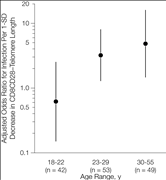研究揭开有些人易患感冒谜题
| 导读 |
为什么有些人更容易患感冒?美国卡内基-梅隆大学研究人员2月20日发表的研究报告说,原因可能在于这部分人的白细胞端粒较短。
端粒是包括人类在内的许多生物染色体末端的结构,它就像鞋带末端的塑料套一样,能够保护染色体不被磨损。但随着细胞自身不断分裂,端粒的长度会变短,因此端粒长度被看作细胞老化程度的标志。
[attach]1409[/attach... |

为什么有些人更容易患感冒?美国卡内基-梅隆大学研究人员2月20日发表的研究报告说,原因可能在于这部分人的白细胞端粒较短。
端粒是包括人类在内的许多生物染色体末端的结构,它就像鞋带末端的塑料套一样,能够保护染色体不被磨损。但随着细胞自身不断分裂,端粒的长度会变短,因此端粒长度被看作细胞老化程度的标志。

为研究端粒长度与急性疾病的关系,研究人员在美国匹兹堡地区征集了152名年龄在18岁至55岁之间的健康成年人,并采集了他们的血样以测量白细胞端粒长度。然后研究人员让他们使用含有普通感冒病毒的滴鼻剂,接下来的5天隔离监控这些人的病毒感染情况。
数据分析发现,白细胞端粒较短的人接触感冒病毒后的感染风险要高于端粒较长者。值得注意的是,随着成年人年龄增加,白细胞端粒长度“预测感冒”的能力就越强。其中,一种特定类型的白细胞——CD8CD28-T细胞的端粒长度“预测感冒”的能力最强。
研究人员介绍说,这类白细胞的一个重要作用就是清除已感染病毒的细胞,但它们的端粒与其他类型白细胞相比,缩短得更快。此前就有研究发现,这类白细胞端粒缩短与免疫系统标记物减少有关。他们推测,感冒病毒来袭时,端粒较短的T细胞无法像端粒较长的T细胞那样增殖迅速,因此难以高效清除受感染的细胞。
相关研究报告发表在新一期《美国医学会杂志》上。研究人员表示,端粒长度可能是疾病易感性的一种非常稳定的标记物。不过他们也提醒说,其研究仅是初步结果,是否具有临床意义仍未可知。
来源:新华网
原文链接:
Association Between Telomere Length and Experimentally Induced Upper Respiratory Viral Infection in Healthy Adults
Importance Although leukocyte telomere length is associated with mortality and many chronic diseases thought to be manifestations of age-related functional decline, it is not known whether it relates to acute disease in younger healthy populations.
Objective To determine whether shorter telomeres in leukocytes, especially CD8CD28− T cells, are associated with decreased resistance to upper respiratory infection and clinical illness in young to midlife adults.
Design, Setting, and Participants Between 2008 and 2011, telomere length was assessed in peripheral blood mononuclear cells (PBMCs) and T-cell subsets (CD4, CD8CD28+, CD8CD28−) from 152 healthy 18- to 55-year-old residents of Pittsburgh, Pennsylvania. Participants were subsequently quarantined (single rooms), administered nasal drops containing a common cold virus (rhinovirus 39), and monitored for 5 days for development of infection and clinical illness.
Main Outcome Measures Infection (virus shedding or 4-fold increase in virus-specific antibody titer) and clinical illness (verified infection plus objective signs of illness).
Results Rates of infections and clinical illness were 69% (n = 105) and 22% (n = 33), respectively. Shorter telomeres were associated with greater odds of infection, independent of prechallenge virus-specific antibody, demographics, contraceptive use, season, and body mass index (PBMC: odds ratio [OR] per 1-SD decrease in telomere length, 1.71 [95% CI, 1.08-2.72]; n = 128 [shortest tertile 77% infected; middle, 66%; longest, 57%]; CD4: OR, 1.76 [95% CI, 1.15-2.70]; n = 146 [shortest tertile 80% infected; middle, 71%; longest, 54%]; CD8CD28+: OR, 1.93 [95% CI, 1.21-3.09], n = 132 [shortest tertile 84% infected; middle, 64%; longest, 58%]; CD8CD28−: OR, 2.02 [95% CI, 1.29-3.16]; n = 144 [shortest tertile 77% infected; middle, 75%; longest, 50%]). CD8CD28− was the only cell population in which shorter telomeres were associated with greater risk of clinical illness (OR, 1.69 [95% CI, 1.01-2.84]; n = 144 [shortest tertile, 26%; middle, 22%; longest, 13%]). The association between CD8CD28− telomere length and infection increased with age (CD8CD28− telomere length × age interaction, b = 0.09 [95% CI, 0.02-0.16], P = .01, n = 144).
Conclusion and Relevance In this preliminary study among a cohort of healthy 18- to 55-year-olds, shorter CD8CD28− T-cell telomere length was associated with increased risk for experimentally induced acute upper respiratory infection and clinical illness.
 腾讯登录
腾讯登录
还没有人评论,赶快抢个沙发